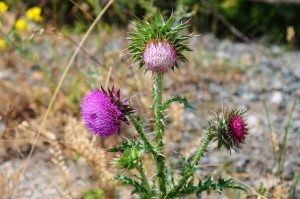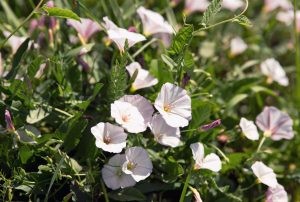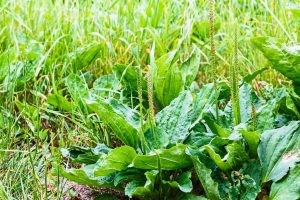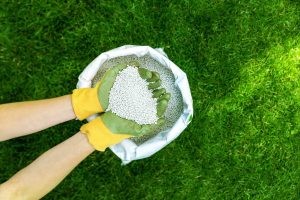At Simple Lawns, we understand the importance of a well-maintained lawn and garden. Unfortunately, weeds are one of the most common issues that can ruin your outdoor space. Here in the Pacific Northwest, there are 10 weed types that tend to be especially troublesome for homeowners. Join us as we help our neighbors identify some of the most common weeds in the Portland, Oregon area!
1. Annual Bluegrass (Poa Annua)
Annual bluegrass is a small, light green grassy weed that can grow to be 6 to 12 inches tall. The leaves of annual bluegrass are long and thin, with a canoe-shaped tip and rolled edges. The seed heads of annual bluegrass are very fine and delicate, with a cotton- or oat-like appearance, and they will appear on the plant in mid-to-late spring. The roots of annual bluegrass are very shallow, which allows the weed to absorb nutrients and water before the deeper roots of your lawn get the chance.

Look For These In Your Yard:
- Light green grass (lighter than turfgrass)
- Smooth leaves with canoe-shaped tips
- Cotton- or oat-like seed head
- Shallow, fibrous roots
2. Crabgrass (Digitaria Sanguinalis)
Crabgrass is an annual weed that germinates from summer to fall, and can be found in both warm-season and cool-season grasses, but it is mainly known as a warm-season annual. It spreads easily through the production of seeds, which form seed heads in long, thin clusters that hang off the stem of the weed. This weed has a shallow root system and tends to spread across large areas quickly if not addressed. The pink center of the plant and the low-outward growth is often said to resemble a crab.

Look For These In Your Yard:
- Light green leaves
- Wide leaves with rounded tips
- Outward, star-shaped growth
- Pink color at base of stems
3. Kochia (Bassia Scoparia)
Kochia is an annual weed that often grows to be more than 2 feet tall in residential lawns. It has a small, spindly stem and distinctive light-green, oval leaves with a slightly wrinkled surface, and they often appear to be fuzzy. Kochia will produce clusters of small yellow flowers during the summer months, which then turn into seed pods in late fall. The seeds of kochia are very tiny and spread easily through wind or water.

Look For These In Your Yard:
- Triangular shape of plant
- Light green, fuzzy leaves
- Small, spindly stems
- Small yellow flowers
4. Dandelion (Taraxacum Officinale)
Dandelion is a broadleaf weed that can be found in both turfgrass and non-turf areas. You know this weed for its bright yellow flowers and fluffy white seed heads, a transformation that takes about 2 weeks. This weed has serrated leaves that grow in a rosette pattern around the base of the plant (which is an easy way to identify the weed before it flowers), and its deep central taproot makes dandelions a nightmare to have to deal with in your lawn or yard.

Look For These In Your Yard:
- Bright yellow flowers
- Cotton-like seed heads
- Deeply serrated leaves
- Deep central taproot
5. Musk Thistle (Carduus Nutans)
Musk thistle is a biennial weed that grows in many lawns in the Pacific Northwest, and it is an ugly intruder that you will want to get rid of immediately! It has light green leaves that are hairless and sharply serrated, and the stem of the weed is narrow and spiny and can grow up to 10 feet tall in ideal conditions. This weed spreads only via seeds, and it is most easily identified by its large size and its round, purple or pink flowers that sit on bracts of spiky leaves.

Look For These In Your Yard:
- Bright purple flowers
- Long, spiny stem
- Deeply serrated leaves
- Large, central taproot
6. Canada Thistle (Cirsium Arvense)
Canada thistle (commonly referred to as creeping thistle) is a perennial weed that grows in a wide variety of climates and soil conditions, making it a real problem for homeowners in our area. It looks very similar to any other type of thistle or wildflower, but it spreads much more rapidly and plants deep taproots. Unlike musk thistle, Canada thistle’s taproot also spreads via underground rhizomes. Thin, prickly stems and purple-to-pink flowers are typically characteristic of this weed.

Look For These In Your Yard:
- Purple or pink flowers
- Thin, prickly stems
- Spiked leaves
- Taproots with fibrous rhizomes
7. Bindweed (Convolvulus Arvensis)
Bindweed is a perennial weed that is known for its fast growth and ability to take over a lawn or garden. This weed belongs to the same family as, and it is often confused for, morning glory flowers in gardens, as this weed produces the same trumpet-shaped flowers. However, as a vine-type weed, its complex root system and its ability to spread quickly through runners makes this weed a tangled mess that will deplete and suffocate your lawn or garden.

Look For These In Your Yard:
- Bright, trumpet-shaped flowers
- Arrowhead-shaped leaves
- Thin, spiraling stems
- Tangled stems and roots
8. Chickweed (Stellaria Media)
Chickweed is an annual, broadleaf weed that can easily be spotted in lawns due to its tiny white flowers. These flowers are star-shaped and delicate, and they can be found across a bed of oval-shaped leaves that appear from early spring to late fall. The stems of chickweed are thin and often have a single line of fine hairs. Stems frequently get tangled around other plants in gardens, and you can expect this weed to create a matted nightmare if it is allowed to spread across your yard.

Look For These In Your Yard:
- Star-shaped flower and sepal
- 5 deeply lobed, white petals
- Low growth
- Matted and tangled growth
9. Creeping Charlie (Glechoma Hederacea)
Creeping Charlie (also known as ground-ivy) is a perennial weed that is known for the way it “creeps” along the surface of the soil, rooting at the nodes. It has small, heart-shaped leaves with scalloped edges, and each leaf is covered in soft hairs. The flowers of creeping Charlie are tiny and have a faint purple, blue, or white appearance, popping up from early spring to late summer. This weed is hated most for its low, tangled growth and complex roots.

Look For These In Your Yard:
- Faint purple, blue, or white flowers
- Scalloped, heart-shaped leaves
- Soft hairs covering the leaves
- Rooting at the nodes
10. Purslane (Portulaca Oleracea)
Purslane is an annual weed that grows in both spring and summer. It has thick, oval-shaped leaves and thick stems that have a reddish color. This plant is considered a succulent because of the flat, thick leaves. The flowers of purslane are yellow, but this weed will do its damage long before it even matures. It has a prostrate growth habit, making yet another tangled mess in your yard. It grows from a single taproot that is surrounded by secondary fibrous roots, which enables this weed to easily overtake the grass in your lawn.

Look For These In Your Yard:
- Small, oval-shaped leaves
- Thick leaves and stems
- Yellow Flowers
- Fibrous, prostrate growth
Subscribe to Simple Lawns's Blog








Comments